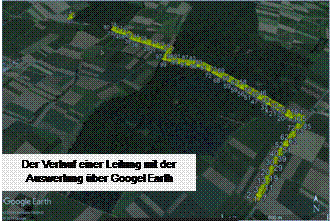Pipeline Detection with georadar
 Despite all efforts to ensure the documentation of the supply lines of a municipality without gaps, we experience time and again that the route of some lines is simply not known. Be it that the lines were taken over by the previous supplier who had no plans or it was simply not documented accordingly in the past.
Despite all efforts to ensure the documentation of the supply lines of a municipality without gaps, we experience time and again that the route of some lines is simply not known. Be it that the lines were taken over by the previous supplier who had no plans or it was simply not documented accordingly in the past.
When remedial measures are pending, it can become problematic. Where and how deep is the line? Likewise, buried tanks, shafts, thick cables or old foundations, we will tell you where you will find what you are looking for by creating a grid of the area where the searched object or the course of the searched pipe can be found.
If the pipe positions of plastic pipes are unknown, radar is the only solution to determine the course of the pipe. Almost no preparatory work is necessary on the part of the client, the line only has to be freely accessible and, if possible, traversable at right angles (2 m in front of and behind). The beginning or the end of the line should be known, then based on the characteristics and the location of the line, its course can be located and documented using GPS. The material of the line is irrelevant, PE lines can be found just as easily as steel, cast or concrete lines.
After a short time you will receive an evaluation with the geographic coordinates of the individual points at which the line was found, which you can transfer to your GIS system. A connection of the points results in the course of the line. The approximate ground cover can be specified on request and depending on the requirements. Our radar can usefully penetrate layers of soil up to approx. 4 m, whereas dry, sandy soils are easier to penetrate than moist, loamy soils, which absorb the transmitted signal more strongly.
The procedure
 Searching for lines with ground penetrating radar or ground penetrating radar is a non-destructive process. The method can be used in all environments. The unique location mode is used for easy identification and accurate display of the position and depth of the objects located in the earth. Here is a geophysical exploration of the subsurface. It is based on the propagation of electromagnetic waves in the ground, these reflect at the layer boundaries of different materials and are then refracted.
Searching for lines with ground penetrating radar or ground penetrating radar is a non-destructive process. The method can be used in all environments. The unique location mode is used for easy identification and accurate display of the position and depth of the objects located in the earth. Here is a geophysical exploration of the subsurface. It is based on the propagation of electromagnetic waves in the ground, these reflect at the layer boundaries of different materials and are then refracted.
The antenna in the ground radar repeatedly sends electromagnetic waves underground. The device is rolled over the surface to be examined, which enables continuous data acquisition. The reflected waves are recorded, recorded and shown on a display. It is therefore possible to view and check the measurements on site. Significant structures can often be identified and marked during the measurement.
The procedure can be used for the following tasks:
- Location of metallic and non-metallic pipes (PVC, asbestos cement, concrete storm and sewage systems)
- Locating supply lines with broken or damaged marking cables
- Identification of underground storage tanks
- Identification and location of drainage tiles
- Identification of non-supply structures (vaults, foundation walls)
The procedure offers you the following options:
- Delimitation of the utilities in the immediate vicinity
- Providing reliable depth estimates
- Enable data visualization to better represent the subsurface
- Report and archive results for future reference
- Integrate data in third party software (e.g. Google Earth)
Line search with georadar prevents damage by precisely locating all buried pipes and cables before excavation. Ground penetrating radar can be used as part of the utility locating workflow to provide more complete locations and reduce risk.




